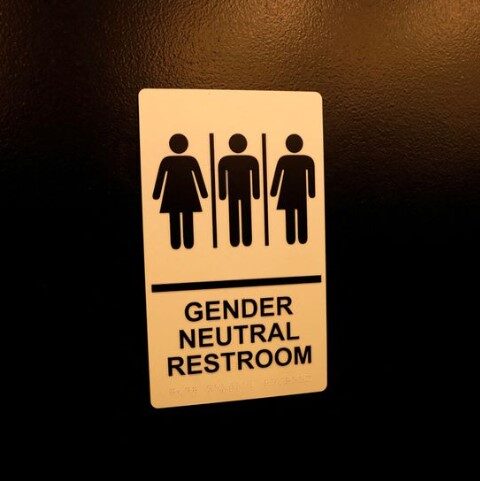
A sign is seen on a gender neutral restroom wall in New York City, U.S., April 19, 2017. REUTERS/Mike Segar/File Photo
Prime Minister Mark Carney will scrap some of his predecessor’s signature policies if his recent budget is passed, but he is seeking to maintain major expenditures related to gender and racial equity programs.
Budget 2025 focuses on large-scale expenditures in a bid to grow the economy while including some cuts to the public service. It also changes the former Liberal government’s plan to plant 2 billion trees by 2031 and eliminates some taxes such as the luxury tax on aircraft and boats.
The new budget also contains a series of new measures around gender issues as well as continued policies for racial minorities and the indigenous peoples. Those are backed with hundreds of millions of dollars in new spending over the next few years. Additionally, the budget adds the Department for Women and Gender Equality and Indigenous Services Canada to the list of departments required to find only 2 percent in savings over the next three years, rather than the 15 percent required of other departments.
The Liberal government’s 2024 budget emphasized initiatives for the black and indigenous communities while maintaining existing commitments for LGBT programs. Budget 2025, for its part, has more government spending on gender equality and LGBT programs while providing relatively fewer new commitments for programs related to racial minorities and indigenous peoples.
Gender Programs
Budget 2025 provides far more funding for initiatives focused on gender issues compared to Budget 2024.
Budget 2024 allocated funding to several domestic and international women-focused programs, with its most expensive being the Feminist International Assistance Policy (FIAP). As part of a 2019 commitment related to women’s health and reproductive issues over a 10-year period, from 2020 to 2030, the budget included increasing global health funding to reach $1.4 billion on average per year starting in 2023, with half of that dedicated to sexual and reproductive health issues.
Unlike the previous budget, this year’s budget makes no mention of the Feminist International Assistance Policy, but instead forecasts $2.7 billion in cuts to foreign aid over the next four years, from 2026–27 to 2029–30.
Budget 2024 said it would provide, starting in 2024–25, $3 million over two years to Women and Gender Equality Canada to support security needs for Pride festivals, and $12 million to the department over five years to fund projects “aimed at combatting hate against the 2SLGBTQI+ community.“ The acronym stands for ”Two-Spirit, lesbian, gay, bisexual, transgender, queer, intersex, and additional people who identify as part of sexual and gender diverse communities.”
Then-Prime Minister Justin Trudeau said in a podcast with the Canadian Women’s Foundation that Budget 2024 was focused on “fairness for all Canadians” and that the government wanted to support women in particular through the national gender-based violence strategy and continued investments in child care.
When it came to the sexual minorities programs, Budget 2024 made references to existing commitments rather than announcing new ones. This included nearly $150 million over 10 years for the Federal 2SLGBTQI+ Action Plan announced in 2022, and $10 million annually for the LGBTQ2I International Assistance Program first announced in 2019.
While Budget 2025 highlights that most government departments are working toward cuts of 15 percent over three years, starting in 2026–27, it proposes to give the Department for Women and Gender Equality (WAGE) $528.4 million over four years beginning in 2026–27 to “continue conducting its critical work towards eliminating discrimination and advancing the rights of women and 2SLGBTQI+ communities.” Budget 2025 said WAGE had its annual savings target set at just 2 percent because of its “critical work.”
The budget also proposes $223.4 million over five years beginning in 2026–27, with $44.7 million ongoing, to “strengthen federal action on gender-based violence.”
On additional sexual minorities programs, Budget 2025 proposes $54.6 million over five years, starting in 2026–27, with $10.9 million ongoing, to support the “2SLGBTQI+ community sector,” which includes $7.5 million over five years, with $1.5 million ongoing, for security for Pride parades.
Carney, who raised a Pride flag on Parliament Hill in June to celebrate Pride Month, said federal money was needed to make Pride parades safer. He noted that there had been “backlash” against the community around the world and that Canada would “always stand up for the vulnerable and the equal rights we cherish.”
In his speech on the 2024 budget, Trudeau said that through the budget, the government was “making even greater investments to combat hate toward 2SLGBTQI+ people and build a safer, more inclusive country for everyone.”
For his part, on Budget 2025, Carney did not specifically mention women or sexual minorities during an Oct. 22 speech outlining the government’s priorities for the upcoming budget. That speech focused on plans to grow the economy, cut government spending, make the country an “energy superpower,” diversify trade beyond the United States, and reduce immigration.
Funding for Racial Equity and Indigenous Programs
Budget 2024 introduced several initiatives specifically to assist the black community and indigenous peoples, while Budget 2025 in comparison, contains fewer new measures specifically allocated for these groups.
Budget 2024 said black Canadians have historically faced “disproportionate social and systemic challenges, including experiences of racism and discrimination, socioeconomic inequality, a lack of access to culturally appropriate services, and stigma related to accessing mental health care.”
That budget proposed $4 million over two years, starting in 2024–25, for the Public Health Agency of Canada to continue supporting initiatives through the Mental Health of Black Canadians Fund, which was established in 2018. The budget noted that since 2015, the federal government has provided more than $760 million to programs created for black Canadians, including a $265 million funding allocation for the Black Entrepreneurship Program first introduced in 2020.
Ahead of Budget 2024, Trudeau said Ottawa was seeking “a fairer future for every generation of indigenous peoples,” and that “reconciliation will be at the forefront of everything we do.”
For indigenous peoples, Budget 2024 laid out funding of over $9 billion over six years, from 2023–24 to 2028–29, for various programs. Among other initiatives and services, this included $1.5 billion for indigenous early learning and child care, nearly $1.2 billion for First Nation education ranging from kindergarten to Grade 12, and $1 billion for First Nations and Inuit health.
Budget 2024 also announced up to $5 billion in loan guarantees for a new Indigenous Loan Guarantee Program, which would allow indigenous groups to participate in natural resource development and energy projects.
Budget 2025 contains virtually no new initiatives meant specifically for black Canadians, but mentions how policies like removing “assault-style” firearms, establishing a new Financial Crimes Agency, and strengthening anti-money laundering laws would help “black and racialised communities” and other “various diverse, often vulnerable, groups.”
The budget mentions that the proposal of requiring regular legislative reviews of amendments to the Farm Credit Canada Act is needed because farm operators are “predominantly older White men” and there are “traditionally underrepresented groups such as women, youth, Indigenous, 2SLGBTQI+, and Black and racialised entrepreneurs” that may particularly benefit from regular legislative reviews.
Indigenous peoples also received fewer new initiatives in Budget 2025 compared to previous year’s budget. New funding includes $2.3 billion over three years, starting in 2026–27, for clean drinking water in First Nations communities and $10.1 million over three years, starting in 2025–26, for indigenous consultations on the major projects that are being fast-tracked.
Indigenous Services Canada and Crown-Indigenous Relations and Northern Affairs Canada (CIRNAC) also saw around $2.3 billion in cuts over five years, as it worked to identify savings of 2 percent. The budget said that the government “remains committed to reconciliation” and that the two departments would “deliver important programs that are legally or constitutionally required.”
Budget 2025 said CIRNAC and Indigenous Services Canada will have to find savings of just 2 percent rather than 15 percent over three years, as they are needed to “deliver important programs that are legally or constitutionally required” and help advance reconciliation.
Carney said in his Oct. 22 speech ahead of the budget that Ottawa would build major projects “in full partnership with Indigenous peoples, First Nations, Inuit, and Métis.” The prime minister held consultations with those three groups earlier this year around the One Canadian Economy Act, which aims to speed up the development of major projects such as pipelines, ports, and railways.
Matthew Horwood is a reporter based in Ottawa.
